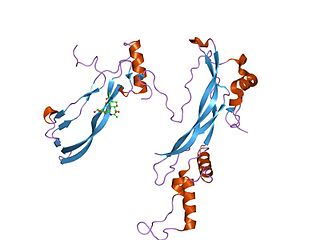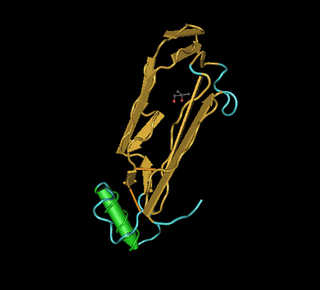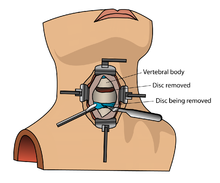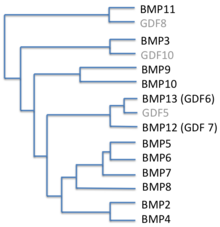
Spinal fusion, also called spondylodesis or spondylosyndesis, is a surgery performed by orthopaedic surgeons or neurosurgeons that joins two or more vertebrae. This procedure can be performed at any level in the spine and prevents any movement between the fused vertebrae. There are many types of spinal fusion and each technique involves using bone grafting—either from the patient (autograft), donor (allograft), or artificial bone substitutes—to help the bones heal together. Additional hardware is often used to hold the bones in place while the graft fuses the two vertebrae together. The placement of hardware can be guided by fluoroscopy, navigation systems, or robotics.

Chondrogenesis is the process by which cartilage is developed.

Bone morphogenetic protein 7 or BMP7 is a protein that in humans is encoded by the BMP7 gene.

Bone morphogenetic protein 2 or BMP-2 belongs to the TGF-β superfamily of proteins.

Bone morphogenetic protein 4 is a protein that in humans is encoded by BMP4 gene. BMP4 is found on chromosome 14q22-q23.

Bone morphogenetic protein 6 is a protein that in humans is encoded by the BMP6 gene.

Bone morphogenetic protein 3, also known as osteogenin, is a protein in humans that is encoded by the BMP3 gene.

The bone morphogenetic protein receptor, type IA also known as BMPR1A is a protein which in humans is encoded by the BMPR1A gene. BMPR1A has also been designated as CD292.

Anterior cervical discectomy and fusion (ACDF) is a surgical procedure to treat nerve root or spinal cord compression by decompressing the spinal cord and nerve roots of the cervical spine with a discectomy, followed by inter-vertebral fusion to stabilize the corresponding vertebrae. This procedure is used when other non-surgical treatments have failed.
Growth differentiation factors (GDFs) are a subfamily of proteins belonging to the transforming growth factor beta superfamily that have functions predominantly in development.

Growth differentiation factor 2 (GDF2) also known as bone morphogenetic protein (BMP)-9 is a protein that in humans is encoded by the GDF2 gene. GDF2 belongs to the transforming growth factor beta superfamily.

Growth differentiation factor-3 (GDF3), also known as Vg-related gene 2 (Vgr-2) is protein that in humans is encoded by the GDF3 gene. GDF3 belongs to the transforming growth factor beta (TGF-β) superfamily. It has high similarity to other TGF-β superfamily members including Vg1 and GDF1.

Growth/differentiation factor 5 is a protein that in humans is encoded by the GDF5 gene.

Growth differentiation factor 6 (GDF6) is a protein that in humans is encoded by the GDF6 gene.

Growth differentiation factor 10 (GDF10) also known as bone morphogenetic protein 3B (BMP-3B) is a protein that in humans is encoded by the GDF10 gene.
A metabologen is defined as a morphogen (molecule) that can initiate, promote and maintain metabolism and homeostasis. Based on this definition, bone morphogenetic proteins (BMPs) are metabologens, since they are involved in iron homeostasis, brown fat adipogenesis and energy metabolism. Professor A. Hari Reddi and Anand Reddi in Cytokine Growth Factor Rev were the first to propose the term metabologen.
A. Hari Reddi is a Distinguished Professor and holder of the Lawrence J. Ellison Endowed Chair in Musculoskeletal Molecular Biology at the University of California, Davis. He was previously the Virginia M. and William A. Percy Chair and Professor in Orthopaedic Surgery, Professor of Biological Chemistry, and Professor of Oncology at the Johns Hopkins University School of Medicine. Professor Reddi's research played an indispensable role in the identification, isolation and purification of bone morphogenetic proteins (BMPs) that are involved in bone formation and repair. The molecular mechanism of bone induction studied by Professor Reddi led to the conceptual advance in tissue engineering that morphogens in the form of metabologens bound to an insoluble extracellular matrix scaffolding act in collaboration to stimulate stem cells to form cartilage and bone. The Reddi laboratory has also made important discoveries unraveling the role of the extracellular matrix in bone and cartilage tissue regeneration and repair.
A bone growth factor is a growth factor that stimulates the growth of bone tissue.
Nicolaas Duneas is a South African biochemist and developer of osteogenic biomaterials. He is the co-founder and CEO of Altis Biologics. The company developed the first injectable treatment for bone injuries that require grafting by using a pig-based growth material.

Thomas Schuler, M.D., F.A.C.S is an American spinal surgeon, researcher and educator in the treatment of neck and low back conditions. He was an early adopter of stem cell therapy, biologics, robotics, laser and hybrid surgery and augmented reality for spinal surgery. Schuler specializes in cervical and lumbar disc replacement procedures, minimally invasive spine surgery and robotic spine surgery. He performed the first hybrid multi-level cervical artificial disc replacement with spinal fusion in the country. He founded a practice that has performed some of the first robotic and augmented reality spinal surgeries in the world. In 2002 he created and currently serves as President of the National Spine Health Foundation, a national non-profit focused on education, research and patient advocacy of neck and back health.
















